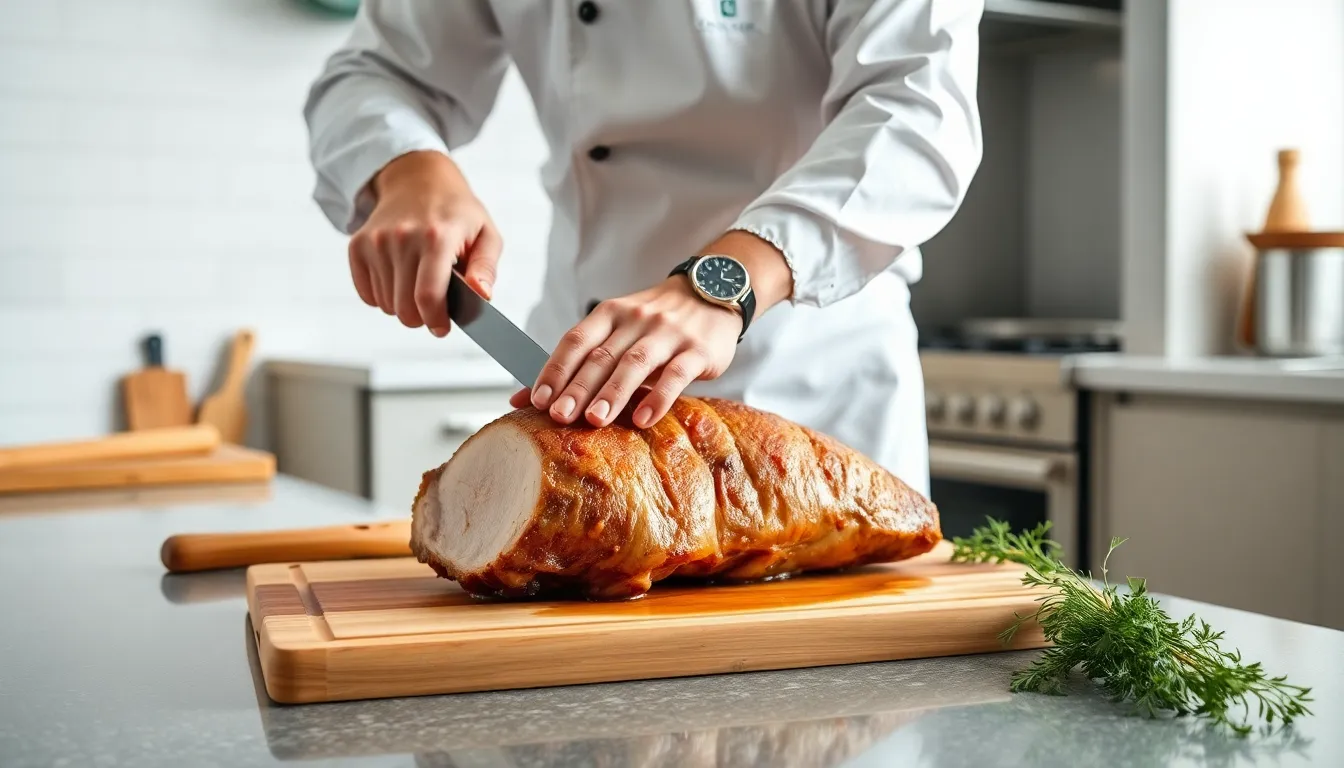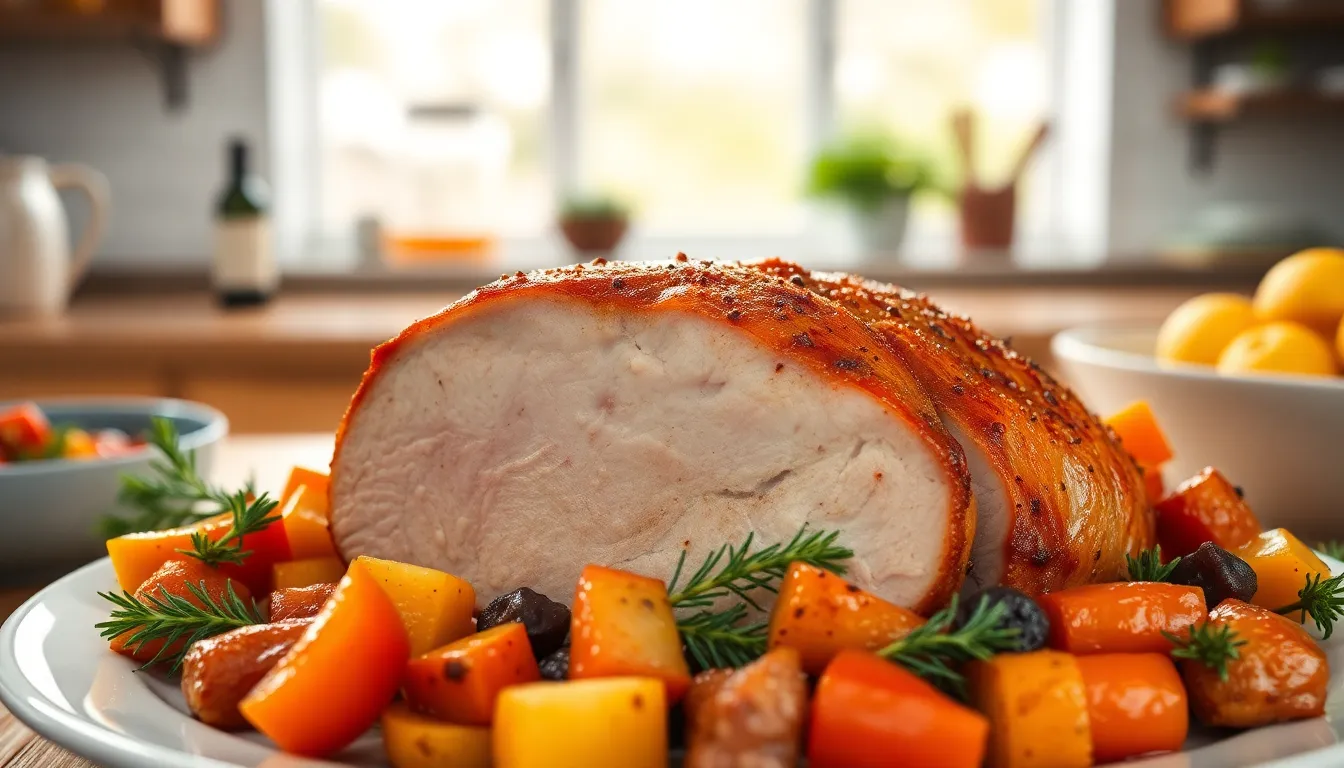Baking a pork roast is like throwing a culinary party where the star of the show is a juicy, tender hunk of meat that practically begs to be devoured. Imagine the mouthwatering aroma wafting through the air, making everyone wonder if they should bring their own forks or just show up for the feast. It’s not just a meal; it’s an experience that can elevate any gathering from ordinary to unforgettable.
Table of Contents
ToggleUnderstanding Pork Roasts
Baking a pork roast requires an understanding of its types and cuts. Knowledge of these essential details greatly enhances the cooking experience.
Types of Pork Roasts
Various types of pork roasts exist, each offering unique flavors and textures. The most common types include pork loin, shoulder, and tenderloin. Pork loin is lean, tender, and perfect for roasting. Shoulder, known for its rich marbling, yields juicy results after slow cooking. Tenderloin is more delicate, ideal for quick cooking methods that keep it moist.
Selecting the Right Cut
Selecting the right cut for roasting impacts the overall outcome. Look for cuts with sufficient fat to ensure moistness during cooking. Pork loin provides a balance of tenderness and flavor, while the shoulder emphasizes richness. Chefs often recommend tenderloin when a quick roast is preferred. Seasoning and marinades also work well with any cut, enhancing the natural flavors. Understanding these attributes consistently leads to a successful pork roast.
Preparing the Pork Roast

Preparing the pork roast involves careful selection and treatment of the meat. Proper preparation enhances flavor and texture, ensuring a satisfying end result.
Marinades and Seasonings
Marinades infuse the pork with additional flavor. Citrus juices like orange or lemon brighten the meat, while soy sauce adds depth. Choose herbs such as rosemary, thyme, or sage for freshness. Consider adding garlic or mustard for a savory kick. Apply the marinade several hours before baking, or overnight for deeper taste. Seasoning with salt and pepper before cooking enhances the pork’s natural flavors. Use a good quality olive oil to help the seasonings adhere better and create a delightful crust during roasting.
Trimming and Tying Techniques
Trimming excess fat ensures a balanced cook and reduces greasy texture. Look for large areas of fat and carefully remove them with a sharp knife. Maintain a thin layer of fat to retain moisture and flavor. Tying the roast provides even cooking and an appealing shape. Use kitchen twine to tie the roast at intervals along its length. Make sure the ties are snug but not tight enough to inhibit expansion during cooking. This technique secures any loose pieces and helps the roast maintain its structure.
Baking the Pork Roast
Baking a pork roast requires attention to temperature and timing. The right conditions ensure a delicious outcome.
Ideal Oven Temperature
Choosing the ideal oven temperature is essential. Set the oven to 350°F for standard roasting. Some prefer using a higher temperature of 450°F for the first 20 minutes to develop a crust before reducing it back to 350°F. Maintaining consistent heat encourages even cooking, resulting in tender meat. An internal temperature of 145°F guarantees a safe and juicy roast. Always check the thickest part of the meat for accuracy.
Cooking Times and Techniques
Determining cooking times depends on the roast size and cut. A general rule is to cook pork for about 20 minutes per pound at 350°F. Using a meat thermometer enhances precision, preventing overcooking. Basting every 30 minutes helps maintain moisture and flavor. For larger roasts, consider covering them with foil to retain heat during the initial cooking phase. Remove the foil during the last 30 minutes for a golden-brown exterior.
Checking Doneness
Checking doneness ensures the pork roast is safe and flavorful. Accurate measurement of internal temperature and visual cues confirms perfect cooking.
Using a Meat Thermometer
A meat thermometer is vital for precision. Insert it into the thickest part of the roast, avoiding bone to prevent inaccurate readings. Aim for an internal temperature of 145°F for pork. A quick check during cooking reveals if additional time is necessary. Pull the roast from the oven when it hits the target temperature and let it rest for at least 10 minutes. Resting allows juices to redistribute, enhancing flavor and moisture.
Signs of a Perfectly Cooked Roast
Visual indicators help gauge doneness. Look for a golden-brown crust on the outside, signaling a well-cooked surface. Juices should run clear, not pink, when the roast is cut. Finally, check the meat’s texture; it should be firm yet tender. Each of these signs contributes to achieving a succulent and enjoyable pork roast.
Serving Suggestions
Serving a pork roast opens up a world of culinary possibilities. Enhance the dining experience by thoughtfully pairing sides and presenting the dish beautifully.
Sides That Pair Well
Roasted vegetables bring out the natural flavors of pork. Consider serving carrots, potatoes, and Brussels sprouts for a colorful platter. Additionally, creamy mashed potatoes complement the richness of the roast. A fresh apple or cabbage slaw adds a crisp texture and balances the meal. Homemade gravy, made from pan drippings, elevates the dish further. Don’t overlook crusty bread; it invites guests to savor every bite.
Presentation Tips
Start by slicing the pork roast against the grain to enhance tenderness. Arrange slices on a large platter for an appealing display. Garnish with fresh herbs like rosemary or thyme; they add visual interest and freshness. Serve alongside bowls of your selected sides, positioning them within reach. Use white serving dishes to create a striking contrast against the golden-brown meat. Highlight the roast with decorative elements such as seasonal fruits or edible flowers for an extra touch.
Baking a pork roast is more than just preparing a meal; it’s about creating an unforgettable experience. The rich flavors and enticing aromas set the stage for gatherings filled with warmth and camaraderie. With the right cut of meat and careful attention to seasoning and cooking techniques, anyone can achieve a succulent roast that impresses guests.
Taking the time to rest the roast and thoughtfully pairing it with delicious sides enhances the overall dining experience. Whether it’s a special occasion or a cozy family dinner, a perfectly baked pork roast brings people together and leaves lasting memories. By following these guidelines, anyone can master the art of baking a pork roast and elevate their culinary skills.





